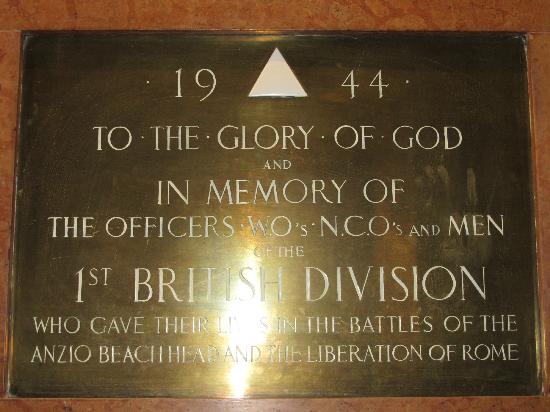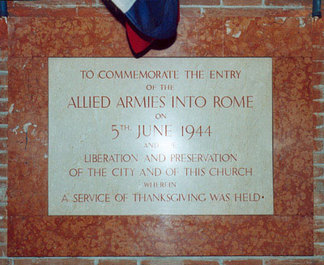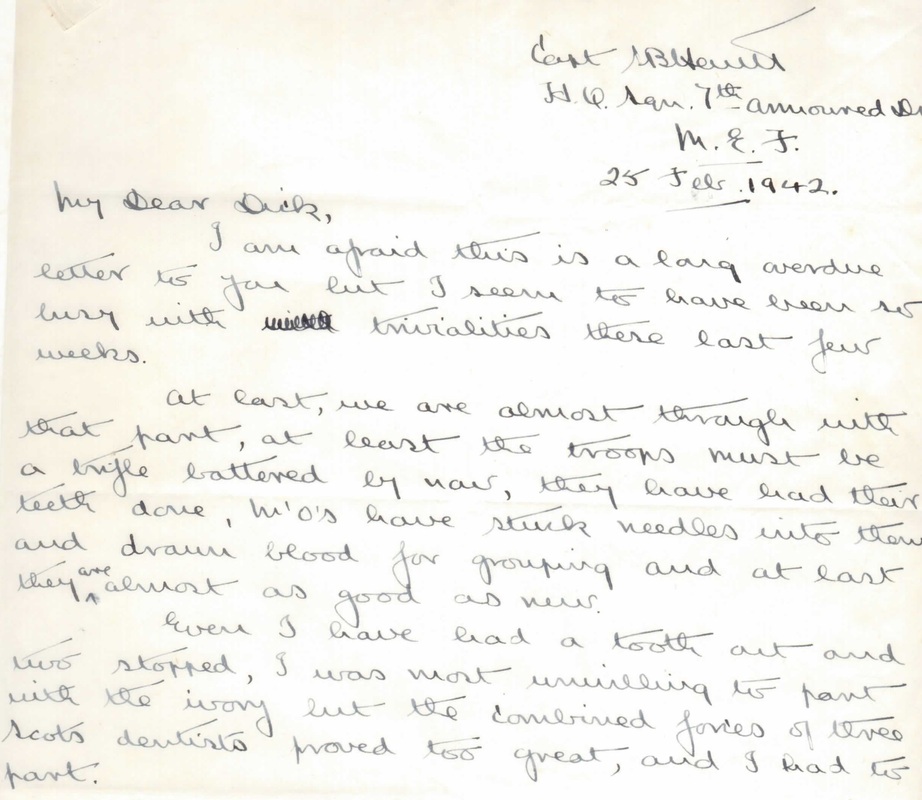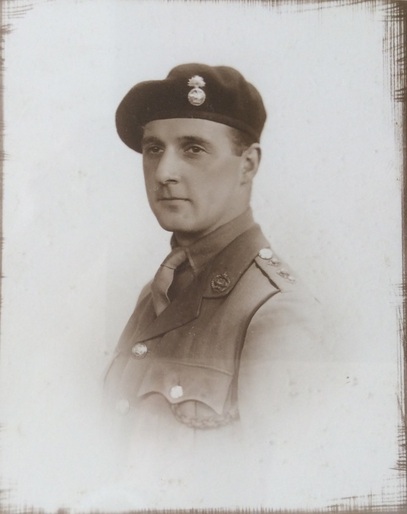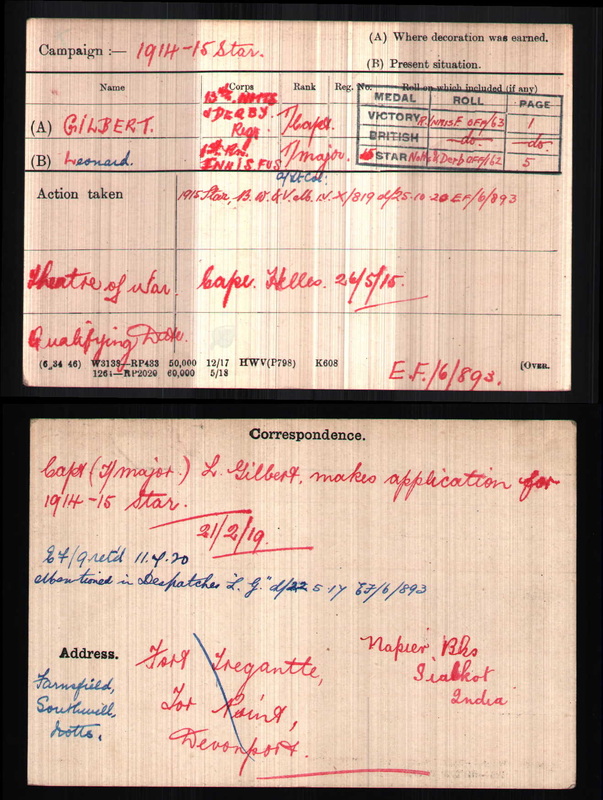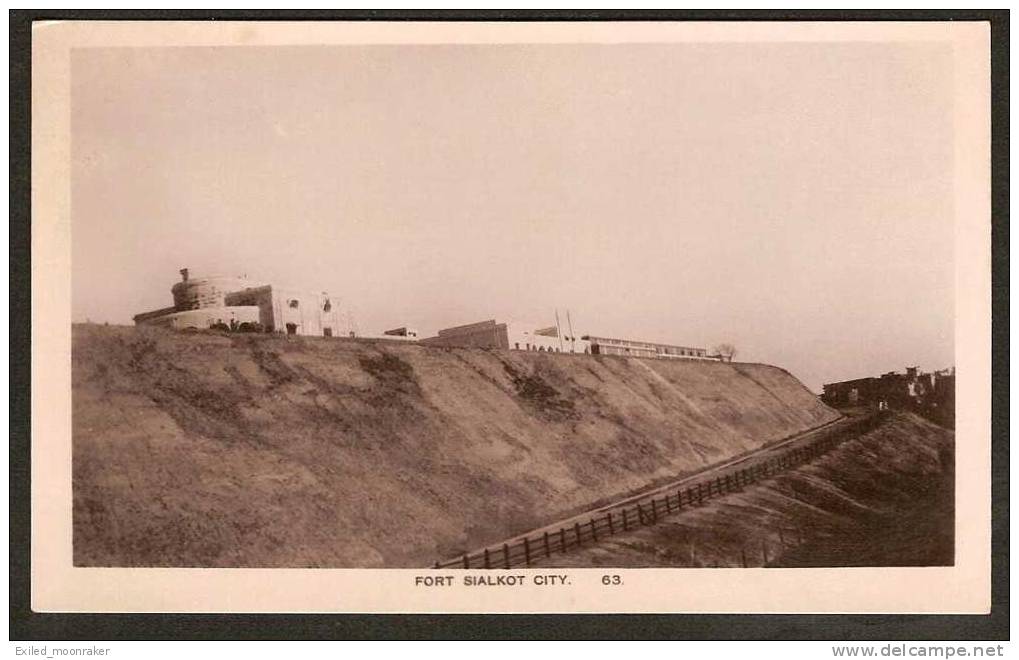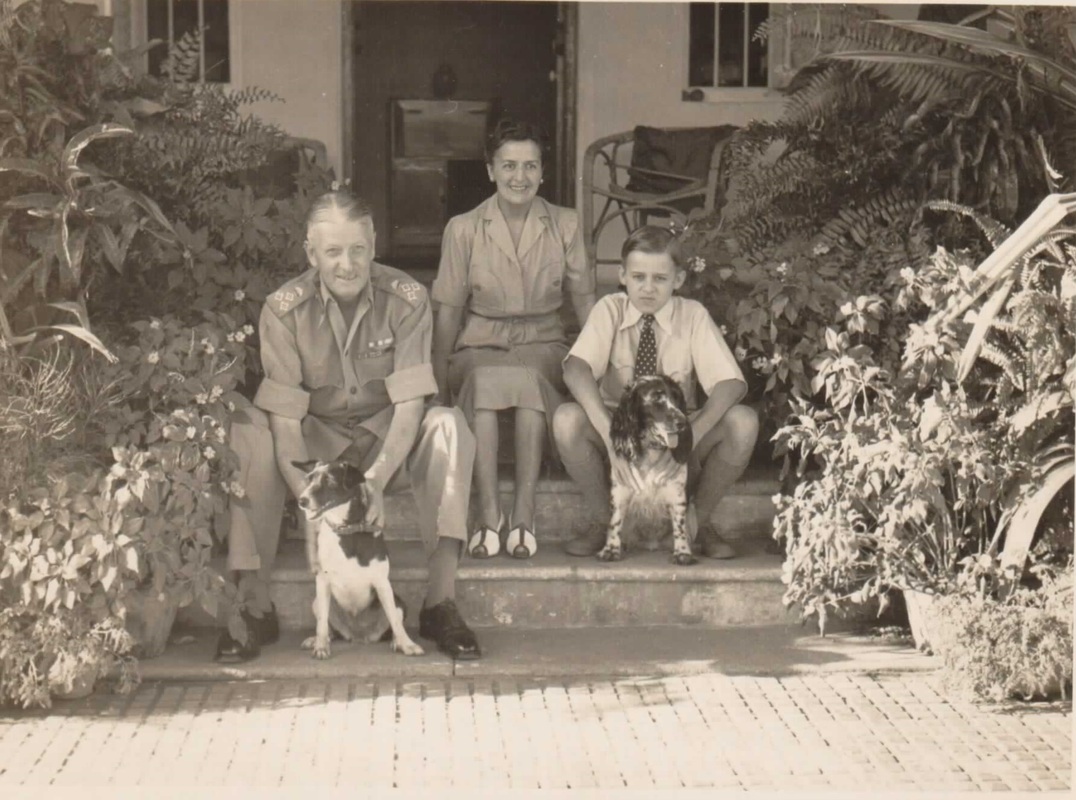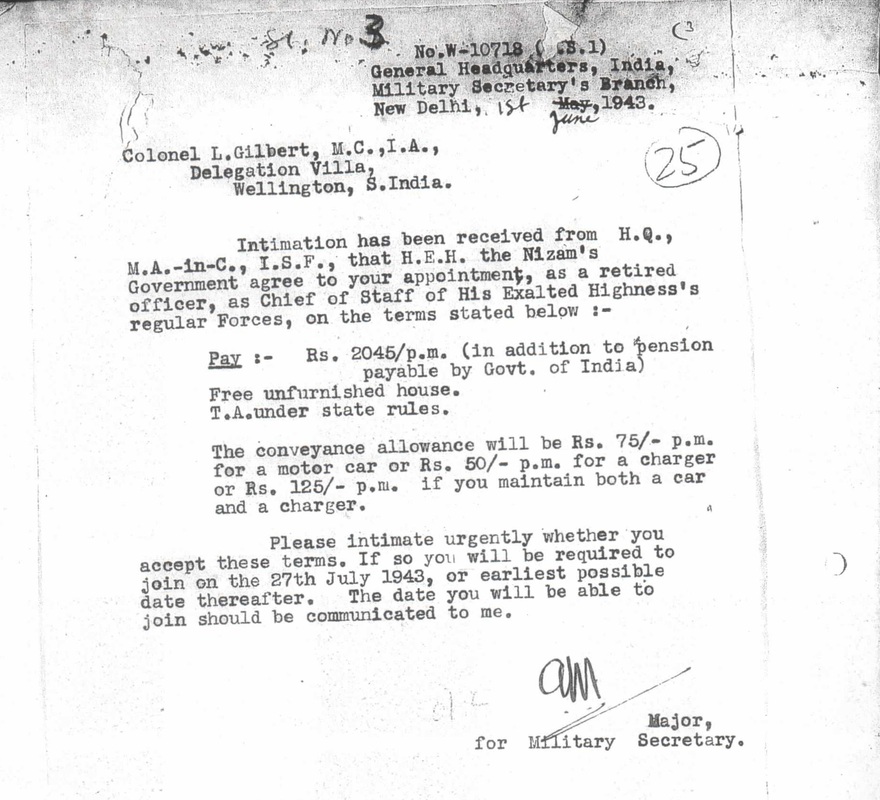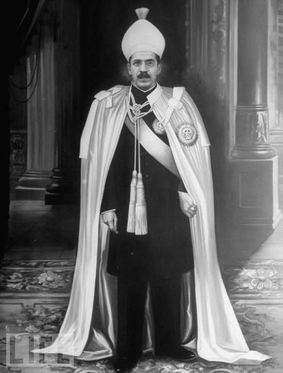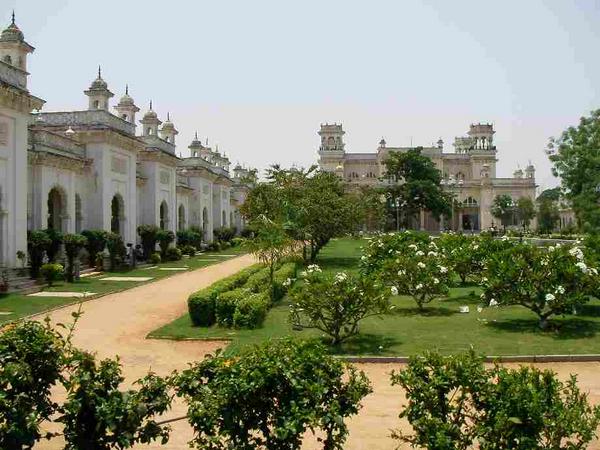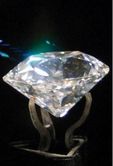IntroductionThis months blog post had a somewhat unusual start to life. In some ways it happened purely by chance, on the other hand it has always been there, lurking in the wings, waiting to be told. It began whilst on holiday in Rome, where on the 3rd June I happened upon the Anglican church of "All Saints" in the Via Babuino , close to the foot of the Spanish Steps. On display inside to the rear of the Church were the flags of the Allied Nations that liberated Rome on the 4th June 1944, accompanied by two commemorative plaques from the grateful citizens of Rome. It was here that a service of Thanksgiving was held on the June the 5th 1944. BBC Archive recording from Rome on 5th June 1944. My interest was grabbed and my mind drifted back to another event that took place the previous year, September 1943 in the South of Italy at Salerno. Knowing Major Stephen B Hewitt had been made an Honorary Citizen of the town in March 1944 I was now determined to find out why. Grasping the nettle and speaking no Italian, I boldly made a request of the Hotel Cavalieri guest relations. The lovely Serena was more than helpful and by the end of the following day I was in touch with the Salerno Archives and was in possession of the document conferring the honour - in Italian! Not to worry a quick run through an on-line translation programme, although far from perfect, gives the general gist:- "Deliberation n . 144 Of 3.17.1944 the Mayor Silvio Baratta Further communication with the Salerno Archives ensued, the result - Major S B Hewitt is to be remembered as part of the "Salerno Capitale" 70th anniversary commemorations in September this year. Whilst compiling a digital biography for this purpose, I was contacted by "Who Do You Think You Are" magazine who were looking for researcher's personal research stories. Stephen's very abridged biography features in their latest newsletter which was extracted from the following:- Stephen Burgess Hewitt T.D. J.P 10.6.1913 - 10.10.1970Stephen Burgess Hewitt was born on the 10th June 1913 in Jesmond, Newcastle. He was the second and youngest son of Nathanial Naylor Hewitt a fourth generation fruit broker of the firm of Connolly Shaw Ltd, one of the founder members of the London Fruit Exchange. (As featured in April post http://www.bordersancestry.co.uk/blog/oranges-and-lemons-potatoes-pomegranates-and-melons) Stephen’s mother was Evelyn Burgess a descendent of a Birmingham Lamp Manufacturer who according to family tradition enjoyed a monopoly for ships fittings granted in the reign of Elizabeth I. Her grandfather's love of the good things in life and a disastrous copper contract with the Admiralty combined with the outbreak of the Franco Prussian War resulted in the closure of the firm. This left Evie's father Henry without the luxury of a ready made business. Making his own way, it was he who took the first steps towards establishing the Newcastle textile wholesaling firm of Roland Burgess Ltd. Stephen attended Durham School where he excelled at sport, particularly rowing. It was here that he enjoyed his first taste of the military as a sergeant major in the Officers Training Corps. On leaving School he joined the 6th Battalion Northumberland Fusiliers as 2nd Lieutenant and was transferred to the Royal Tank Regiment on the 1st November 1938. He was finally mobilised on 25th July 1940 to the Middle East with the 7th Armoured Division. From here he writes to his brother on 25th February 1942. But it was to be the events that unfolded after the Allied landings in Salerno, Southern Italy in September 1943 that would prove to be the most influential in some many lives, including his own. As Town Major he writes in December 1943:- “I am still very busy, no job is outside my scope, at the moment my area covers about 80 square miles, with many towns and villages. I am really responsible for housing all the troops in such places, in addition here I have collected two clubs an Officers Leave and Transit Camp, a Town Guard Room and a civilian housing committee which has had to house about 35,000 people. I have also managed to get started a Civilian Transit Camp because it was quite common for me to have a family of 20 just come and squat in my Office at about 9 O’clock at night, so that I organised that one to save myself some bother .” He continues in the same letter:- “I may add most of these are not my job but people are so slow at seeing the need for certain things and then so slow in getting something going, that I find I am diving into it. Good old Nosey Parker.” On the 17th March 1944 he was made an Honorary Citizen of the City of Salerno, then temporary Capital of Italy, for his work in restoring a degree of normality to civilians whose lives had been severely disrupted by war. It is for this gratitude of the people that he will be remembered as part of the 70th Anniversary of “Salerno Capitale” commemorations. His letters illustrate his great sense of humour in the face of such an enormous task. On one occasion during a brief period of leave, he finds himself stemming the tide of a burst pipe in his rented villa with a mop and bucket. Another example from a letter dated April 1945 whilst in Rome for four days.. There are many more along similar lines: - whilst in Salerno he adopts a dog which proceeds to eat his chair, has a ‘run in’ with a Nun expecting miracles, his batman breaks his fishing rod and in 1945 he is still waiting for his golf clubs to arrive from Cairo! Post war, Stephen returned to the UK and to the firm of Connolly Shaw Ltd. He never married and died at his home Wreighburn House in Thropton, Northumberland on 10th October 1970 aged just 57. He was survived by his brother Richard Naylor Hewitt MBE, his sister Kitty Hindmarsh and five nieces and a nephew. One such niece would subsequently marry the nephew of another Army Officer with an equally interesting story to tell. Brigadier Leonard Gilbert C.I.E, M.C.Leonard Gilbert was born March 1889 in Farnsfield, Southwell, Nottinghamshire to parents Benjamin Gilbert, a tailor by profession and his wife Maria Caunt. In 1911 Leonard was a student at Mapperley Hall Teacher Training College. A bit more digging and he appears in 1912/1913 as an Assistant Master at the Dukes School in Alnwick, Northumberland, when and where I am sure, he met his future wife Reniera Davison, a native of the town. With the outbreak of War Len enlisted with the 13th Notts & Derybshire Regiment or the "Sherwood Foresters" as they subsequently became known. By the time of the landings at Cape Helles, Gallipoli on 26th May 1915 he was also a temporary Major in the 1st Battalion Inniskilling Fusiliers. After the War had ended, Len returned home and was married by his brother the Rev Thomas Gilbert, to Reniera Davison at St Michaels Parish Church, Alnwick in January 1919. In the 1920's Honour List he was awarded the Military Cross. What on earth for. Further investigation and with the help of Forces War Records I uncovered the following:- "Gazette Issue 31759. M.C. Awarded the Military Cross. His Majesty the King has been graciously pleased to approve of the undermentioned rewards in recognition of gallant conduct and determination displayed in escaping or attempting to escape from captivity, which services have been brought to notice in accordance with the terms of Army Order 193 of 1919. To date 5th May, 1919." So where and when was he captured?, a further record on Forces War Records shows that a Lt Col L Gilbert, 10th Brigade of the Sherwood Forester's was captured on the 23rd April 1917 and repatriated on the 18th Dec 1918. Unfortunately the record does not give a location, but tracing the actions in which the 10th Sherwood Foresters were engaged, it would appear most likely it was at the second Battle of the Scarpe, Arras, France on the Western Front. Alas as the International Red Cross POW archives are closed due to digitisation until 4th of August it is impossible to be certain. Although conditions in the Officers POW camps were less harsh than those endured by the troops, the officers themselves were not exempt from punishment. Conditions in troop "Reprisal Camps" following an escape were so harsh that many died. Reprisal camps for officers existed too. The fortress of Ingolstadt was temporary home to amongst others Charles de Gaulle and Roland Garros. Until the ICRC website goes live in August I can only speculate on Lens fate. IndiaMilitary life obviously suited Len, from his medal card information we can see that he is, by 1920 stationed at Napier Barracks, Sialkot, India. In 1924 his wife Reniera sailed from England to Karachi to join him. On the 18th December 1928 their son John Dethick Gilbert was born at Multan, West Bengal. During this period he rose steadily up the ladder of seniority. On the 10th of July 1940 Len's rank rose to that of Temporary Brigadier and in 1943 as Commandant of the Army Training School in Bangalore he was made a "Companion of the Most Eminent Order of the British Empire", or C.I.E. In the same year he retired from the Iandian Army and negotiations commenced for a most unusual post, that of Chief of Staff to HEH the 7th Nizam's Regular Forces. The 7th and Last Ruling NizamThe 7th Nizam of Hyderabad Mir Osman Ali Khan Siddiqi Bahadur accedded to title in 1911 on the death of his father. As Nizam he was absolute ruler of the largest princely state of Hyderabad in pre-independent India, some 86,000 square miles. Not only was he reputedly the richest man in the world he was also one of the most eccentric. he was quoted by Iris Portal wife of British Politician Rab Butler and who had been in Hyderabad in the 1930's as being "Mad as a coot". Iris had befriended one of the Nizam's daughters in law, who had once shown her the vaults beneath a royal palace, where dozens of trucks lay parked up in various stages of decay but still full of gold, silver and precious gemstones. The Nizam had at one time feared revolution and had made plans for the removal of a proportion of his portable wealth. Plans that were subsequently abandoned.
Following "Operation Polo" the state finally succumbed to the Indian Army in September 1948, when the monarchy was disbanded and Mir Osman Ali Khan found himself Nizam in name only. The 7th Nizam died in February 1967, and the title passed to his grandson Mukarram Jah whom he had nominated as his heir. He inherited his grandfathers immense wealth, but several divorces and litigation by several thousand rival descendants of various Nizams, all claiming a piece of his inheritance, rapidly depleted his reserves. From the beginning he was forced to sell jewels and heirlooms to stay solvent and by the 1990's he had been striped of the majority of his ancestral assets. In 1973 disgusted by the family in fighting he had removed himself to a sheep station in Perth Australia, where he spent his days driving bulldozers. In his absence the royal palaces were looted and the remainder of his possessions dispersed by unscrupulous advisers. Jacob or Victoria
During the many bitter inter family financial disputes that would plague the 7th Nizam's later life, and indeed that of his successor, various pieces of jewellery and gems came up for sale in 1951. Amongst these was the "Jacob" for which the Indian Government refused permission, given the gem's national importance. Five years later, again the diamond was reputedly for sale, and again the Indian Government intervened. It was not until after the 7th Nizam's death in 1967 and protracted legal wrangling's that the Nizam's jewel collection was eventually bought by the Indian Government in 1995 for $70 million. To date there has been no further mention of the "Victoria", the "Imperial" or the "Great White" Is the "Jacob" in fact the one and the same diamond that once graced the 7th Zizam's desk wrapped in newspaper? ConclusionWhilst the Nizam's sorry tale of riches to rags in less than 30 years was not a direct result of war, it serves as a timely reminder of the cataclysmic effects that revolution can cause to an individual as well as a country.
More important than the material are the long lasting psychological effects of war. Not only for those who fought and survived, but those who survived so seriously maimed they were unable to provide for their families, those who were unable to fight and the inexplicable guilt they felt at not being able to do so, and of men too young to go to war who lost their youth replacing their fathers in the fight for survival at home. A poignant fact to end on . In a report issued by the United Nations on 20th June this year it is stated that "the number of refugees, asylum seekers and internally displaced people worldwide has, for the first time in the post World War II era, exceeded 50 million people"
0 Comments
Leave a Reply. |
AuthorSusie Douglas Archives
August 2022
Categories |
Copyright © 2013 Borders Ancestry
Borders Ancestry is registered with the Information Commissioner's Office No ZA226102 https://ico.org.uk. Read our Privacy Policy
